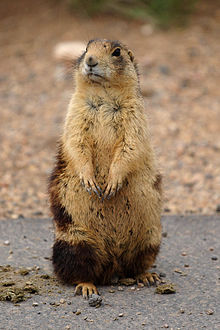- Utah prairie dog
-
Utah prairie dog 
Conservation status Scientific classification Kingdom: Animalia Phylum: Chordata Class: Mammalia Order: Rodentia Family: Sciuridae Genus: Cynomys Species: C. parvidens Binomial name Cynomys parvidens
Allen, 1905
Utah prairie dog range in 1920 (ochre), 1970 (yellow) and 1991 (red) The Utah prairie dog (Cynomys parvidens) is the smallest species of prairie dog, a member of the squirrel family of rodents native to the south central steppes of the US state of Utah.
Like all prairie dogs, the Utah prairie dog is an active forager, eating a wide array of vegetation including grasses, flowers, and seeds and sometimes insects. It is a small mammal, usually standing just 9.8–15.7 inches (25–40 cm) long[2], and weighing about 1.5–3 pounds (0.68–1.4 kg).[3] Its fur has a brown coloring, and it has a white-tipped tail.[3] They build extensive "towns" of underground tunnels and chambers, each town composed of a population of members of an extended prairie dog family. Many other species make use of their burrows, including owls, snakes, and other rodents.[citation needed] Litters are 3–6 large.[4]
Conservation status
The species appears in the IUCN Red List of Threatened Species, with a status of Endangered, last assessed in 2008.[1]
The Utah prairie dog is listed as a threatened species by the United States Fish and Wildlife Service. In 1972, studies estimated a population of 3,300 Utah prairie dogs in 37 colonies. Studies by the Utah Division of Wildlife Resources in Spring 2004 reported 4,022 Utah prairie dogs, a number believed to reflect half of the total current population.[5] The Utah prairie dog can do significant damage to farms by digging holes and eating crops, drawing the ire of Utah farmers, who have used poison liberally to destroy the animal.[3] This is a major reason for the population decline, though there are other factors, such as "land development, deteriorating rangeland health, the encroachment of woody vegetation, sylvatic plague, and drought." Conservation efforts include encouraging landowners to improve the health of their rangelands, and compensating farmers who set aside areas that the prairie dogs may use.[3]
References
- ^ a b Linzey, A. V., Rosmarino, N. & NatureServe (Willson, K., Roth, E., Hammerson, G. & Cannings, S.) (2008). Cynomys parvidens. In: IUCN 2008. IUCN Red List of Threatened Species. Downloaded on 6 January 2009.
- ^ http://ecos.fws.gov/speciesProfile/profile/speciesProfile.action?spcode=A04A
- ^ a b c d Environnmental Defense Fund: Utah prairie dog
- ^ Reid, Fiona A. (2006). Mammals of North America. ISBN 0-395-93596-2.
- ^ US Fish and Wildlife Service: Utah prairie dog
External links
- prairie dogs videos (in English)
- Smithsonian: North American Mammals: Cynomys parvidens
- Mammalian Species account for Utah prairie dog
- Audio recordings of the Utah Prairie Dog
This ground squirrel article is a stub. You can help Wikipedia by expanding it.

